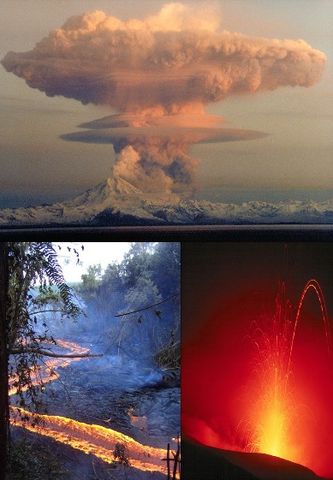Volcanic eruptions are fascinating yet potentially destructive natural phenomena. Here’s an overview of what you need to know about volcanic eruptions:
1. Volcano Basics:
- A volcano is a vent or opening in the Earth’s crust through which molten rock, ash, and gases can erupt. The material that comes out during an eruption builds up to form a mountain-like structure.

2. Types of Volcanoes:
- There are different types of volcanoes, including shield volcanoes, stratovolcanoes (composite volcanoes), and cinder cone volcanoes. The type of volcano is influenced by the composition of the magma and the eruption style.
3. Magma Composition:
- Magma is molten rock beneath the Earth’s surface. The composition of magma (silica content) influences the type of eruption. High-silica magma tends to be more explosive, while low-silica magma is generally less explosive.
4. Eruption Styles:
- Volcanic eruptions can range from effusive to explosive:
- Effusive Eruptions: These involve the relatively gentle outpouring of lava. Shield volcanoes are often associated with effusive eruptions.
- Explosive Eruptions: These involve the violent release of gas, ash, and volcanic rocks. Stratovolcanoes are often associated with explosive eruptions.
5. Volcanic Products:
- Lava: Molten rock that reaches the Earth’s surface during an eruption.
- Pyroclastic Flows: Fast-moving, extremely hot mixtures of ash, lava fragments, and gases.
- Ash Clouds: Fine particles and debris ejected into the atmosphere during an eruption.
6. Ring of Fire:
- A significant portion of the world’s volcanoes, including many of the most active ones, is located around the Pacific Ocean in what is known as the Ring of Fire. This area is seismically active and prone to volcanic activity.
7. Volcanic Hazards:
- Volcanic eruptions can pose various hazards:
- Pyroclastic Flows: Extremely dangerous and fast-moving flows of hot gases, ash, and volcanic rocks.
- Lahars: Rapid mudflows triggered by volcanic activity, often involving melted snow or ice.
- Ashfall: The settling of volcanic ash over an area, which can disrupt air travel, damage crops, and pose respiratory risks.
8. Monitoring and Prediction:
- Scientists use various tools to monitor volcanic activity, including seismometers, gas analyzers, and satellite imagery. Monitoring helps in predicting eruptions and issuing early warnings to nearby populations.
9. Volcanic Impact on Climate:
- Large volcanic eruptions can inject large amounts of ash and gases into the stratosphere, affecting global climate. Volcanic aerosols can reflect sunlight, leading to temporary cooling known as volcanic winter.
Volcanic eruptions are a natural part of Earth’s dynamic processes, shaping landscapes and influencing ecosystems. While they can be hazardous, advancements in monitoring and research contribute to our understanding of volcanic activity and help mitigate the risks associated with eruptions.









